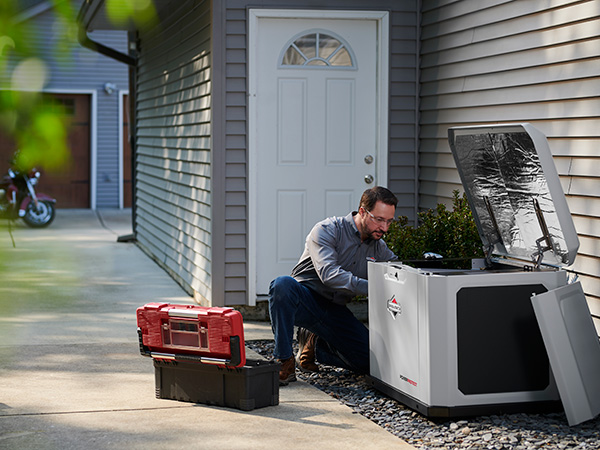Standby Generators vs Portable Generators: Which is Right for You?

July 27, 2023
When power outages occur, backup generators can provide electricity to keep your home running smoothly. Two popular options are standby generators and portable generators, each with their own pros and cons. Determining which is better suited for your needs depends on several factors. This guide examines the key differences to consider when deciding between a standby or portable generator.
What is a Standby Generator?
A standby generator is permanently installed outside or in a protected area near your home. It is wired directly into your home’s electrical system and configured to automatically turn on seconds after an outage occurs. This provides backup power to your entire home or just selected essential circuits.
Standby generators run on propane or natural gas, so there is no need to refill gas tanks. They can continually run as long as fuel is supplied, providing unlimited backup electricity. This makes them ideal for long-term outages, though an automatic transfer switch is required to safely connect the generator to your home.
Installing a standby generator requires professional help as electrical work is involved. Expect to pay anywhere from $5,000 to $15,000 depending on the generator size and additional installation costs. Permits may also be required. Maintenance is minimal, but it must be tested periodically.
Key Benefits:
– Automatically supplies backup power seconds after an outage
– Can power your entire home continuously
– Runs on natural gas or propane so no refueling needed
– Ideal for frequent or long-term outages
– Permanent solution that is always ready
What is a Portable Generator?
Portable generators offer flexible, movable backup power. They run on gas and range from small models around 1,500 watts to larger 10,000+ watt capacity industrial models. You take the generator outside when needed, plug in appliances directly or connect to a transfer switch.
Small portable generators are highly affordable at $500 to $1,500. Larger gasoline-powered models go up to $3,000-$4,000. Installation is not necessary, providing a simpler, DIY setup. Maintenance involves regular oil changes, filter cleaning, etc.
You’ll need to monitor the generator while running and refill the gas tank as needed. Running time is limited by the size of the gas tank – usually 8-12 hours for mid-size models. Extension cords must be used carefully to avoid overloads. Portable generators are better suited for temporary or occasional outages.
Key Benefits:
– More affordable option starting under $500
– Easy to set up as needed without installation
– Compact and movable
– Useful for temporary power needs
– Gas models can provide mid-level power for several hours
Key Differences
There are several key factors to weigh when deciding between standby and portable generators:
Power Output
The larger standby generators can provide power for an entire home, from 20kW up to 50kW or more. Portable generators often max out at 10kW for gasoline models, but industrial diesel generators are available in larger capacities. Make sure to choose adequate wattage for your needs.
Fuel Source & Runtime
Standby generators have an uninterrupted fuel supply from natural gas or a large exterior propane tank. Portable generators require periodic refueling based on gas tank size and fuel efficiency. For long outages, standby generators have the advantage.
Installation
Standby generators are permanently fixed in place and wired into your home’s electrical system. Portable units are plug-and-play so you can set them up quickly as needed.
Cost
Portable generators start under $500 while standby models range from $5,000 to $15,000 installed. Choose based on your budget constraints.
Outage Frequency
If you live in an area with frequent short outages, a standby generator offers the best reliability and convenience. For occasional outages, a portable model may suffice.
In summary, standby generators provide whole-home backup power automatically while portable generators offer flexible, movable power for temporary usage. Keep these factors in mind when deciding which type best suits your specific needs and situation.
5 Key Questions to Ask Yourself
1. What do I need to power?
Determine the essential appliances and devices you want to run during an outage. Adding up the wattage will help size the generator appropriately. Prioritize critical medical devices, refrigerators, phone chargers, home office equipment, etc.
2. How often and for how long do outages occur?
Frequent short outages favor standby generators that can supply continuous backup power automatically. For occasional outages, a portable unit may meet your runtime needs.
3. What is my budget for a backup generator?
Portable models start around $500. Standby generators average $5,000-$15,000 installed. Keep long-term fuel costs in mind as well.
4. Do I need professional help installing a generator?
Portable generators only require an extension cord so they can be DIY. Standby generators require professional electrical installation. Factor in these labor costs.
5. What fuel source makes sense for my home?
If you have natural gas, a standby generator can hook directly in. For off-grid use, propane or gasoline are common options. Assess noise and ventilation for gas models.
Carefully considering these questions will help you select either a standby or portable generator tailored to your household’s unique needs and constraints. Both can provide reliable backup electricity during power outages – it mainly comes down to weighing convenience vs costs.


